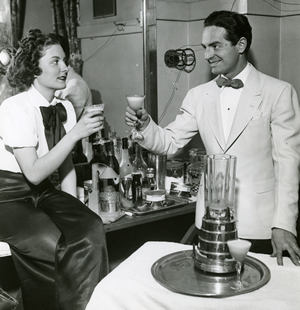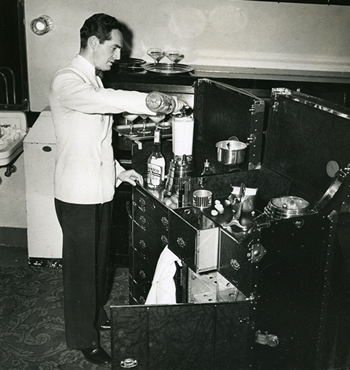Music was not the only interest of Fred Waring—he was a dreamer with an extremely active mind and had been interested in gadgets since he was a kid. In 1936, a man named Frederick J. Osius showed him an undeveloped and seemingly unworkable device. Osius had talked his way into Waring’s dressing room after a radio broadcast and told Waring of his idea for an emulsifying machine, for which he had been able to secure a patent in 1933. Waring was intrigued and decided to help him with ideas, money, and marketing.
Over the next few months, Waring analyzed and studied Osius’ prototype. He decided it needed sealed ball bearings for the bottom drive, propeller-like blades, and a cloverleaf-shaped jar to throw the contents back down. A buddy at the Chrysler Corporation secretly helped him solve the ball-bearing problem. Finally the Waring Mixer, as it was then called, was ready to be presented to the world. Frederick J. Osius unfortunately did not live to see public acceptance of his brainchild, though the royalty arrangement was inherited in trust by his widow.
Selling the public on such a new concept was the major hurdle, especially since sophisticated marketing techniques were still years in the future. Waring became the machine’s biggest promoter—making the machine as visible as possible and persuading everyone to sample its products.
The members of the Pennsylvanians who played the role of collective guinea pigs for Waring’s concoctions, referred to the newly named Waring Blendor as the “thing.” It traveled with them in its own converted wardrobe trunk filled with lemon squeezer, can opener, cutting utensils, glasses, ice, strainers, and measurers. It was accompanied by another trunk containing canned goods ranging from sauerkraut to mangoes.
Waring involved the Pennsylvanians in tasting his creations as well as promoting them. Musicians would demonstrate the device in Macy’s, Gimbel’s, or Bloomingdale’s, and tell everybody how wonderful it would be to make fresh vegetable and fruit drinks. The popular singer, actor, and bandleader Rudy Valle also became a big promoter of the Blendor. Once Waring showed Valle how fast and easy it was to make a frozen daiquiri with the Blendor, he became the device’s best salesmen—trying to sell it to every bartender in the United States!
The impact of the Waring Blendor reached far beyond everyday kitchen use for food and drink. Years before antibiotics were in common use, Waring was asked to produce a sealed, stainless steel container for scientific laboratories. The special Waring Aseptic Dispersal Blendor was used by Dr. Jonas Salk to prepare culture media used in developing the polio vaccine.

